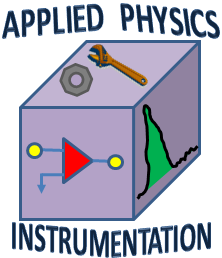Welcome to the Applied Physics & Instrumentation Laboratory
 We are an experimental physics research group located within the Science building. We specialize in designing and building new hardware to study some interesting bit of physics. Our work is supported by state-of-the-art instruments, an electronics design area, a machine shop, and labview and python software environments for hardware pogramming and data analysis.
We are an experimental physics research group located within the Science building. We specialize in designing and building new hardware to study some interesting bit of physics. Our work is supported by state-of-the-art instruments, an electronics design area, a machine shop, and labview and python software environments for hardware pogramming and data analysis.
Active projects: We have two funded projects which are active right now (July 2023).
- Photon correlator project: This is an interdisciplinary project with a biophysics flavor that benefits from critical contributions made by biochemistry majors. The goal of this project is to capture the emission of fluorescent photons from dye molecules. The project involves measuring the arrival times of fluorescent photons to determine the local molecular environment within the diffusion volume. Such projects may be of interest to biochemistry majors who wish to pursue advanced studies, or strengthen their pre-med applications. A research background in biophysics often looks extremely good and makes you very competitive. More details about this project are available on the Photon Correlator page.
-
Magnetic trap project: Another project (with honors intern Jessica Ryun ‘24) is to construct a dynamic magnetic trap to confine neutral objects in free space. Remarkably, the neutral object mathematically behaves as if it were a very large atom. Artificial atoms are fascinating objects – they are large enough we can see them and by building this trap, we hope to study their lifetime and see if we can control their motion as they hover in free space. More details about this project are available on the Magnetic Trap project page.
Some of the projects we have worked on in the past are listed below. Our projects are chosen with some interesting bit of physics in mind and a chance to develop
some new hardware and measurement capability.
- An infrared laser interferometer to measure the vibrations of a mirror (with Ed Lynch,‘13).
- An ultrahigh vacuum chamber to study the switching behavior of small magnetic structures (with Erin Sullivan, `15 and Sean Minster, `14).
- A setup to measure the quantum tunneling of electrons across a small gap (with Alex Holmes, ‘16).
- A setup to measure the electrical transport properties of thin semiconductor films (with Adam Opperman, '20).
- A muon observatory to capture high energy cosmic muons using a coincidence technqiue and to study their decay (with Isaac Volkman, ‘21 and David Nielsen, ‘22).
How much time does research take: Most research work happens during the semester. Students sign up for a 1 credit Physics 388 and agree to work for at least 3-4 hours per week. Most students commit to spending at least two semesters in the lab.
How do you join: Come talk to me (SCI B-201,
pbanerje@uwsp.edu) and I can show you around the lab and discuss project ideas and any open positions. You can also talk to any of my lab students to see if the work is something you might like.
Are there any pre-requisites: Yes, an eager attitude and persistence! Otherwise, anecdotal evidence suggests students feel more comfortable doing physics research after they have completed Physics 250.
What skills might you gain: Experimental physics research will sharpen your physics and mathematics skills and will help you develop a more analytical mindset. You will also learn how to design and build things and get them to work. And you will experience the satisfaction of managing a technical project from start to finish.
Contact information:
Palash Banerjee | Professor | Dept of Physics & Astronomy
University of Wisconsin-Stevens Point | Stevens Point WI 54481.
Office: SCI B201 | Lab: SCI C120 | email: pbanerje@uwsp.edu
This page was last updated on 2023-July-31.
